Table of contents
- 111 years of MOTORRAD Where we come from
- 1919 to 1933
- “The motorcyclists in Berlin are in a state of excitement”
- 1933 to 1943
- Growing pressure from the Nazi regime
- 1949 to 1969
- Tachograph at Nurburgring test drives
- From 1969, open end
- Next generation of drivers: the baby boomers
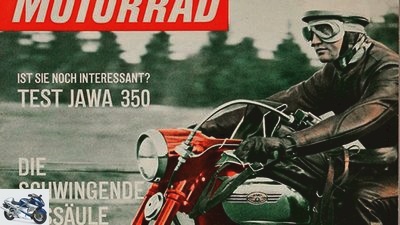
archive
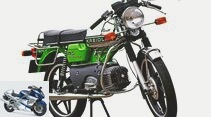
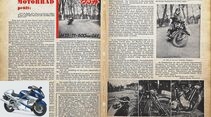
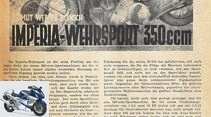
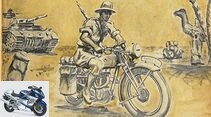
22nd pictures
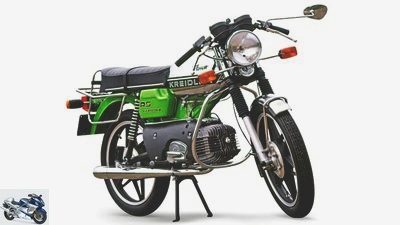
archive
1/22
… many Kreidler RS wore expressive golf green.
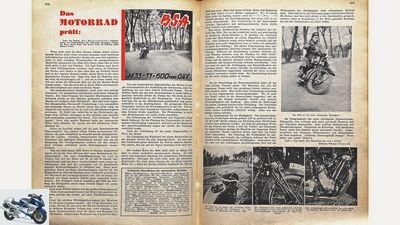
archive
2/22
… One of his first candidates in 1935 was a 600 BSA.
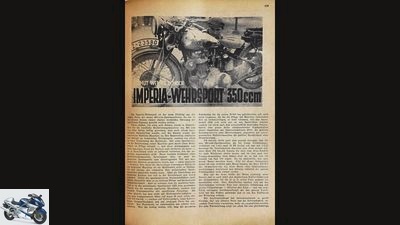
archive
3/22
The magazine got a test motorcycle, Imperia could be sure of the attention of the Wehrmacht.
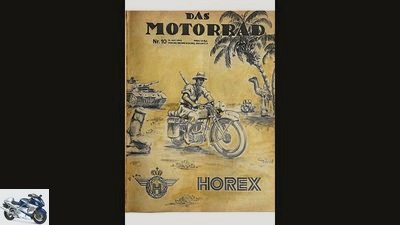
archive
4/22
In the summer of 1942, bright pictures of smiling youths adorned the title …
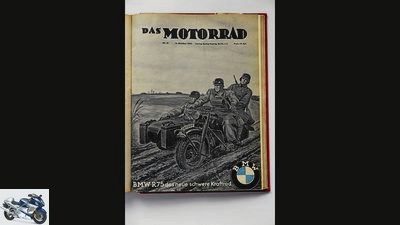
archive
5/22
… The autumn motifs suggest disaster.
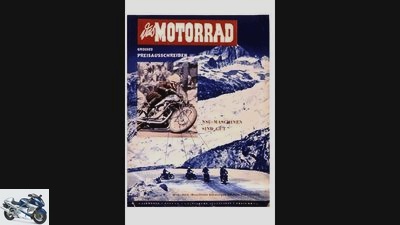
archive
6/22
The first title after the war. Gustav Muller had returned and launched the first post-war editions in 1949. However, he died the following year.
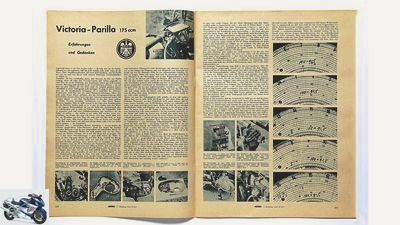
archive
7/22
In 1956, “Das Motorrad” began testing on the Nordschleife, and in 1957 the editors felt their way into using the tachograph with various translations on a Victoria Parilla …
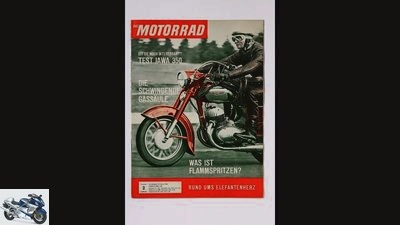
archive
8/22
… The cover picture from 1964 shows the device in use on a test Jawa.
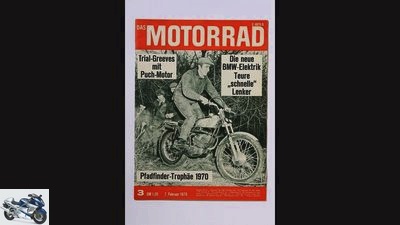
archive
9/22
It’s hard to believe: there are only 14 days between these two issues …
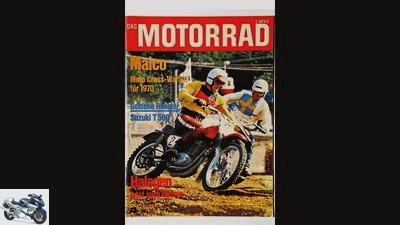
archive
10/22
… In the 70s, colored pages also spread inside, but black and white retreats remained until 1998.
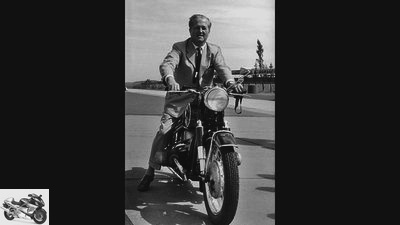
archive
11/22
Helmut Werner Bonsch created the series “Das Motorradprufung” …
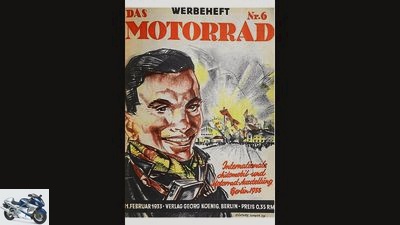
archive
12/22
The dominant theme in the spring of 1933 was the IAMA in Berlin. The young man and the rising sun behind the exhibition grounds spread optimism.
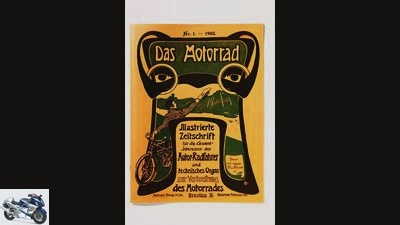
archive
13/22
The first phase is quickly told in the cover pictures: Art Nouveau motif numbered consecutively, …
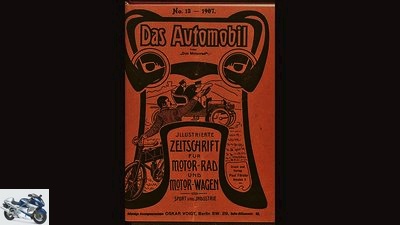
archive
14/22
… Slightly modified in 1907, …
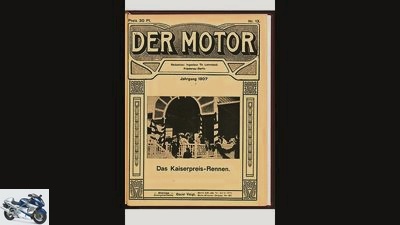
archive
15/22
… rebuilt at short notice and then discontinued.
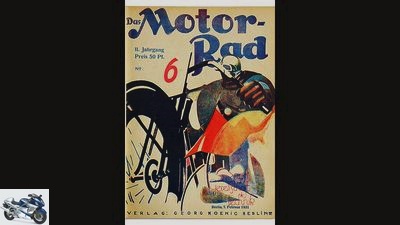
archive
16/22
In terms of art history, “Das Motorrad” has reached Expressionism. This motif graced the title from issue 13/1928 to 27/1931. “Das Motorrad” has been published weekly since 1929.
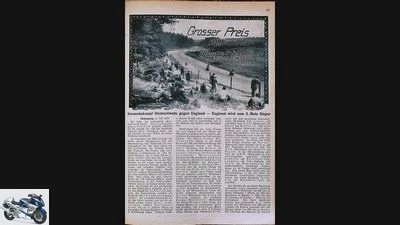
archive
17/22
1928, one year after the opening: racing coverage from the Nurburgring. The ring later became the magazine’s most important test track.
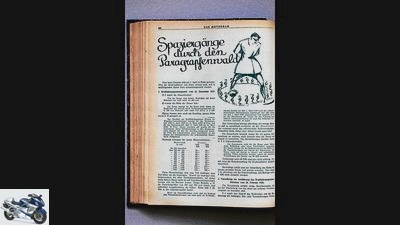
archive
18/22
Comments on laws and regulations took up a lot of space …
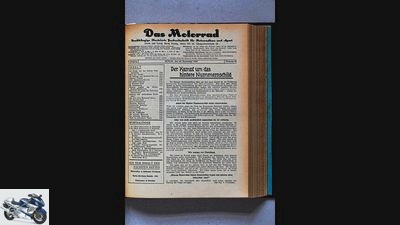
archive
19/22
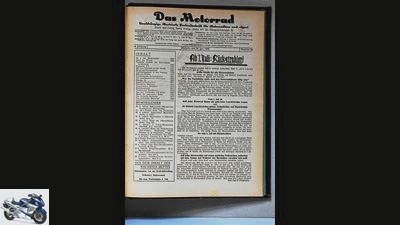
archive
20/22
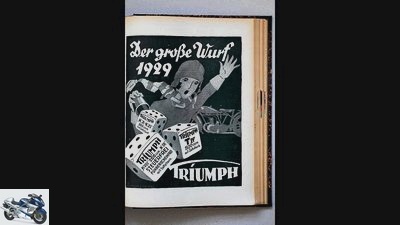
archive
21/22
… The advertising motifs document the high level of graphic art.
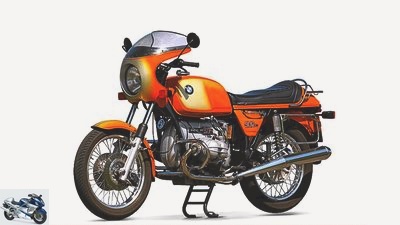
archive
22/22
The BMW R 90 S shone in Daytona orange with a “sunburst” gradient, …
Sports & scene
111 years of MOTORRAD history
111 years of MOTORRAD
Where we come from
111 years of MOTORRAD – a welcome opportunity to leaf through old issues again. It is always astonishing how the “great story” is depicted in our magazine.
Ralf Schneider
07/28/2014
Almost everything was there in autumn 1903: the motorcycles, their drivers, their manufacturers, their suppliers. The advertisements that help fund a magazine, a publisher, editors, expert guest authors. And so the first edition of the new illustrated magazine “Das Motorrad” already offered a rich program on 20 pages plus four cover pages. In impressively modern spelling – around the turn of the century people liked to be “illustrated” instead of illustrated – the publisher and editors set out their goals. Engineers provided calculations for the power requirements of a motorcycle or suggested the installation of “friction clutches” to separate the engine and drive wheel. The Austrian Heinz Kurtz described a “federal hiking trip” on his Neckarsulm motorcycle, and an unnamed author explains the technology of a new Fafnir engine.
Buy complete article
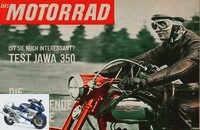
111 years of MOTORRAD
Where we come from
6 pages) as PDF
€ 2.00
Buy now
In the “Umschau”, a topic is already outlined that was to dominate the early years of “Das Motorrad”: “Incomprehensible official harassment”, which allegedly caused serious damage to the automotive industry. In 1906 the draft for a new tax law was debated. “The motorcycle” attested to the “government draft its utter astonishing lack of any expertise”. In fact, as a result of an economic crisis, exacerbated by the new tax, sales of motorcycles and magazines collapsed. Publisher Paul Forster felt compelled to rename the magazine to “Das Automobil” and shortly thereafter, more tactically, to “Der Motor” – following the example of a successful British magazine. But it didn’t help. In 1907 “Der Motor” was discontinued.
1919 to 1933
After the First World War and the turmoil immediately after the war, motorcycles and automobiles picked up speed again, and bureaucracy swelled in their wake. Whether tariff increases, liability insurance, gasoline tax, reflectors or the rear license plate – many of the lead stories in the specialist magazine “Das Motorrad”, which was founded in Berlin, revolved around official requirements and plans. Liability, in particular, was a new concept that caused outrage: “The evil Paragraph 7”, headlined the editorial in 1929, obliges the owner to pay damages, “even if you are innocent”.
There were reasons for the regulation frenzy: The number of motorcycles grew by 75 percent in 1925 to 216,829 units. As early as February 1926, “Das Motorrad” mocked an “unheard of” tax plan. 20 Reichsmarks should be due for each horsepower. On top of that, there was a conversion formula for cheaper two-stroke engines that put them at a disadvantage compared to four-stroke engines: “… you would have to pay just as much for a two-horse DKW machine as you would for an over-compressed five-horse super sports machine, which is a luxury item for the downright sportsman.” Which is the definition of one As far as super athletes are concerned, times have changed significantly.
Finally, a new tax law was introduced in 1928, which, as it is today, based the obulus on the cylinder capacity. Motorcycles and tricycles under 200 cm³ and 350 kilograms were exempt from tax and driving licenses: “… that will help to accelerate the motorization of German economic life to a great extent,” enthused “Das Motorrad” on March 31, 1928. The prediction turned out to be true: The stock increased from 438288 motorcycles in 1928 to 606,400 units in 1929, the majority of them motorcycles up to 200 cm³. Buyers could choose from 62 German motorcycle brands from Arge to Zundapp – plus British, US and French manufacturers.
“The motorcyclists in Berlin are in a state of excitement”
The boom led to problems: “Berlin’s motorcyclists are excited. On Sunday morning police patrols, accompanied by official experts, stand on all exit roads and stop every motorcyclist who goes outside with a smoking and crackling machine, ”writes editor-in-chief Paul Friedmann and condemns the“ hooligans of the country road ”in the article in September 1928 “Unnecessary noise”. The bad guys seem to be mainly the ones who move bikes up to 200 cm³. “It is not absolutely necessary for a tax-free bike like a hundred-horse Mercedes supercharger to frighten harmless passers-by,” complains “Das Motorrad”. And: “It also does not promote motorcycling if all sound-absorbing surfaces and sieves are removed from the mufflers …”
Many letters to the editor get upset about the same topic: “Again and again the audience complains that the motorcyclist is an annoying and dangerous companion on the road,” said a reader, who commented on the crackling, “useless running of the machines on the stand full throttle and the useless use of the short-circuit button “excited. The demand to reintroduce the driver’s license for machines below 200 cm³ is loud. Many readers distance themselves from the “wild” motorcyclists. “Das Motorrad”, which also worries about the bad reputation of German drivers and the increasing number of accidents, turned the tables in November 1929: “It was not the German driver, but the German legislation that was to blame. Finally stop putting every step and every move of the driver in paragraphs. “
1933 to 1943
The most important topic for the editorial team in the spring of 1933 – no, not the rise of the Hitler government to power, but the International Automobile and Motorcycle Exhibition, or IAMA for short, in Berlin. For five issues, the newspaper reported on the fair, for which it had “fought for four and a half years.” The reason for this initiative lies in the economic crisis. Mass unemployment had caused motor vehicle sales to plummet, and the magazine’s circulation also plummeted. The IAMA should give the industry a boost.
The new Chancellor Adolf Hitler gave the opening speech rather by chance – because of an illness of the Reich President Paul von Hindenburg. Hitler announced a four-point program to promote motoring that had already been developed by the Ministry of Finance. The most important point was the abolition of the motor vehicle tax for all new vehicles registered after March 31, 1933.
No wonder that Paul Friedmann enthusiastically celebrated the program in his leading article in issue 12/1933 – and with it its herald. A nasty irony of history, because Hitler deserves credit for this program only for having made it his own, and Hitler’s praise did not prevent Paul Friedmann from having to flee Germany because of his Jewish descent. In the spring of 1933 he handed over the editor-in-chief to his close colleague Gustav “Gussi” Muller, but continued to make contributions. From issue 36/1933 Paul Friedmann no longer appears as an author.
Growing pressure from the Nazi regime
Despite several praises of Hitler in the following years, and although a portrait of the dictator even took the title of the February 3, 1934 edition, it would be wrong to call Gustav Muller a National Socialist. He was probably just as little an opponent as Paul Friedmann had initially been an opponent of National Socialism. However, both are examples of how easily an apolitical stance can be shaken when political awareness is required. Until shortly after the Reichstag elections of January 31, 1933, “Das Motorrad” only dealt with questions of politics in close connection with its subject. After that, the editors had to realize that the apparently apolitical character of this subject could not protect them from the growing pressure of the regime. Whoever is not for us is against us – according to this maxim, dictatorships still force the apolitical on their side and surrender the uncomfortable to persecution. Gustav Muller and his colleagues did not have the strength to rebel against it.
At first things were looking up. Tax breaks, the construction of the motorway (still greeted with joy by Paul Friedmann) and armaments contracts boosted the economy, and the number of motorcycles rose between 1933 and 1938 from around 420,000 to 760,000 machines. Gustav Muller increasingly ran “Das Motorrad” with freelancers, and one of them, Helmut Werner Bonsch, set in motion a development that still defines the magazine today. “I was the computer in the team, collecting data and numbers, I didn’t trust any information if it couldn’t be recalculated or measured.” So the Bonsch computer created a new journalistic genre: “The motorcycle checks”. A standardized test and measurement procedure developed from this. Even a tachograph was already in use in 1935. Unfortunately, the first candidate, a BMW R 17, exceeded the measuring range of the instrument with its top speed of 145 km / h. Although the test work was interrupted in the coming war and post-war years or almost came to a standstill in the motorcycle crisis of the 1960s, the line of development continues up to the 1000-point test of today.
The National Socialist Motorist Corps NSKK, the Motor-HJ or Motor-SS and their sports competitions ran through the editions of these years, and as already mentioned in MOTORRAD 17/2012, the industry vying for orders from the Wehrmacht also ensured a gradual militarization of “Das Motorrad” . In the 13/1935 issue, Helmut Werner Bonsch tested an Imperia 350 Wehrsport, which never went into series production in this form, but was to be offered to the Wehrmacht as a military machine.
Military sport soon turned into serious seriousness. The Wehrmacht gradually called in the employees of “Das Motorrad” for military service. Christian Christophe, “Crius”, was spared because of his French origins and continued to run the magazine until the spring of 1943 with the help of Ernst Rosemann and Siegfried Rauch. As early as 1942, the reading offer consisted largely of optimism in memory: “This is how we won” – under this title Rosemann reported on the successes of German racing drivers in several sequels. The cover illustrations followed the guidelines of the Propaganda Ministry and the course of the war. Light, sand-colored watercolors of motorbikes turning through the desert accompany Erwin Rommel’s initial successes in North Africa. Later that year, mind you, before everything started to go wrong in North Africa and Stalingrad, the illustrator even anticipated the course of the war. The appearance of the title watercolors turned gloomy. The title of the October 19, 1942 edition is shown here as an example. It seems to have sprung from a premonition of impending horror; the rigid faces of the three soldiers in the BMW Wehrmacht team should suggest determination and harshness, but act like death masks.
1949 to 1969
In the first post-war edition of 1949, Gustav Muller thought briefly and emphatically unsentimentally of his colleagues who died in the war. The Koenig publishing house in Berlin sold “Das Motorrad” to Motor Presse Verlag, newly founded by Paul Pietsch and Ernst Troeltsch, and moved to Freiburg, later Stuttgart. Gustav Muller wanted to continue as before the war and was sure that “young people would line up next to the“ good old names ”. “The game can begin” – so his editorial concluded, but he died the following year.
His successor Carl Hertweck had developed a different idea of journalism from the experience of dictatorship and war than that of continuing as before. “Whenever Hertweck saw a uniform, he saw it red,” reports Hans-Joachim Mai, then a junior editor at “Das Motorrad”. Carl Hertweck never crawled to the cross in front of any authority and thus seriously offended the authoritarian young Federal Republic. There was hardly an issue at the kiosk in which he did not target a police president, sports official (15/1953), politician or industrial boss. Some of the feuds he fought are no longer comprehensible today, such as his polemics against NSU’s involvement in racing. Still, he wasn’t a troublemaker. He only saw and criticized more sharply than many others and never tired of asking everyone to think independently instead of adhering to the German belief in authority and a culture of prohibition. In 1958 he had earned enough honors and too many enemies and handed over the editor-in-chief to Siegfried Rauch.
Tachograph at Nurburgring test drives
One of the new additions to the editorial team hoped for by Gustav Muller was Ernst Leverkus in the spring of 1954. When faced with difficult tasks, he motivated himself and others by saying “That’s a no brainer”, and because there were obviously many difficult tasks to be mastered in the early 1950s, his pseudonym developed from this. The young “Klacks” first appeared as a photo model for driving coats and in one of his first articles with a name he appeared very self-confident and opinionated. The polemical brilliance of his editor-in-chief Hertweck was not at his command. The tests became his main topic: He introduced the test drives on the Nurburgring-Nordschleife, and his assessments gained enormous depth as a result of the fact that all components of a motorcycle were challenged far beyond everyday stresses during this driving operation. “Klacks” also took up the idea of the tachograph again, which he had converted from 24 hours to 24 minutes running time per revolution and which he could adapt to the front wheel circumference of different motorcycles with changing gear ratios – an early data recording. The tachograph was mainly used in the Nurburgring test drives; a large pool of data sheets soon made it possible to make precise comparisons.
Unfortunately, after the peak of the post-war boom in 1956, the motorcycle economy went down at least as steeply as in the Fuchsrohre of the Nurburgring. By 1970, the number of motorcycles had dropped from 2.5 million vehicles to around 300,000. In 1959 Ernst Wilhelm Sachs, then a member of the board of directors of Fichtel und Sachs AG, declared the motorcycle dead. At the end of 1962, the circulation of “Das Motorrad” also hit a low point with just under 30,000 copies. It took the foresight and composure of publisher Paul Pietsch to continue the magazine at all.
From 1969, open end
Suddenly there was color in the picture. At first she only used “Das Motorrad” in the title motif, but the change from issue 3 to 4/1970 seems like a symbol of the 1970s that exploded in color. As early as the second half of the 1960s, light had appeared at the end of the tunnel, the first Japanese motorcycles astounded with incredible speeds and liter outputs, and there were increasing signs that BMW was also developing new motorcycles. “Das Motorrad” had crawled out of the trough earlier than the registration numbers.
Unaware of the earlier forerunners, the editorial team celebrated the 50th anniversary of their magazine in 1969, and “Klacks” already suspected in the anniversary issue 22/1969 from which corner the upswing would come. It would not be brought by those who rode to work on a motorcycle and then switched to the car when their affluence grew and their first opportunity came. They had only triggered an “interim boom”, “something that didn’t fit the motorcycle as a vehicle at all.” Perhaps – he mused – the crisis afterwards was even necessary to bring the motorcycle back to its real self: “a to be a sporty vehicle that conveys so much driving pleasure that other points seem insignificant. “
Next generation of drivers: the baby boomers
The generation of drivers who were ready to ignore the “other points”, however, had yet to grow up. These were the baby boomers, the majority of whom had been born during the 60s and who obtained their class four driving license in the 70s in order to pursue their dream of freedom and driving dynamics in the fast 50s. “Boys, your 50s” – the series with the uninhibited chauvinistic slogan began with issue 8/1970 and was published in loose succession.
Before Siegfried Rauch retired at the end of 1976, he cut the article: Since issue 18/1976 the magazine has simply been called MOTORRAD. The new editor-in-chief Helmut Luckner made the series a long-running hit for the youngsters, hired young editors and surfed the boom with his team. This was not an easy time for the old guard, because the young people lived out their dream of a motorcycle in a completely uninhibited way from the way the old hands liked it. Racing drivers like Barry Sheene and Kenny Roberts were role models for the hanging-off style, which at that time was often despised as the “junky style”. Inevitably, the number of accidents rose along with the motorcycle boom. MOTORRAD had to mediate between the motorcyclist-skeptical attitude of the older generation in politics and the enthusiasm of its young readers.
The boys from back then still make up the majority of MOTORRAD’s readership today, and indeed most motorcyclists. And although today they buy magazines and machines more prudently and more cautiously than in the past, one thing is certain: they did not spark an “interim boom” back then. It was permanent.
Related articles
-
What moved the MOTORRAD editorial team in 111 years
archive Sports & scene What moved the MOTORRAD editorial team in 111 years What moved the MOTORRAD editorial team in 111 years You know what …? There…
-
100 years of MOTORRAD: Epochal bikes
MOTORCYCLE archive motorcycles 100 years of MOTORRAD: Epochal bikes 100 years of MOTORRAD: Epochal bikes signpost On the way to becoming a myth, it is…
-
NSU / Audi 11 pictures simplicissimus.info 1/11 The history of the motorcycle began around 1900. BMW 2/11 In the deepest valley of the motorcycle…
-
2014: 10 years of MOTORRAD Alpine Masters
Photo: jkuenstle.de 116 pictures fact, jkuenstle.de 1/116 The extreme seating position was also not ideal for the test track. fact, jkuenstle.de 2/116…
-
100 years of Suzuki Motor Corporation
archive 19th pictures Suzuki 1/19 Suzuki doesn’t just build motorcycles. They make up less than seven percent in sales. Suzuki 2/19 Suzuki can also use…
-
The best stories from 25 years of MOTORRAD Classic
archive Sports & scene The best stories from 25 years of MOTORRAD Classic 25 years of MOTORRAD Classic A quarter of a century MOTORRAD Classic Content of…
-
archive 21 pictures Torsten Kruger 1/21 Marion Reichelt 2/21 Marion Reichelt 3/21 www.fieser-friese.net 4/21 Kerstin Rotard 5/21 Joachim Franke 6/21 Igor…
-
counselor workshop 75 years of Moto Guzzi 75 years of Moto Guzzi The emperor’s new eagle 30,000 Moto Guzzi fans witnessed the rebirth of a motorcycle…
-
20 years of triumph in Hinckley-England
archive counselor traffic & business 20 years of triumph in Hinckley / England Spotlight: History of Triumph 20 years of triumph in Hinckley / England…
-
Development history of the Yamaha BT 1100 Bulldog
motorcycles Development history of the Yamaha BT 1100 Bulldog Development history of the Yamaha BT 1100 Bulldog A fat dog Truly exclusive, this pleasure:…